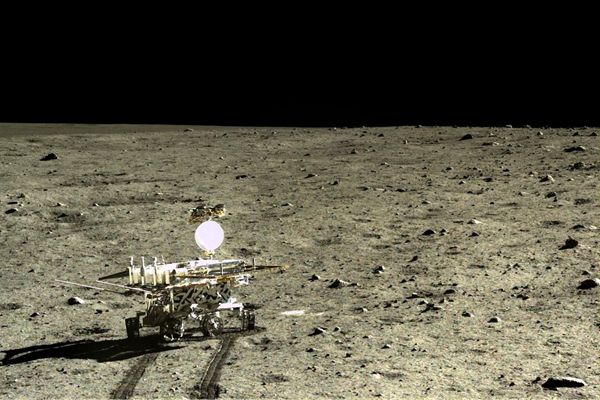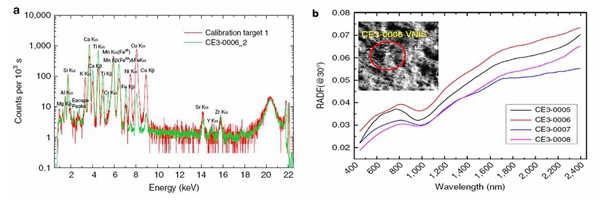
Based on the returned data from China's Chang’e-3 Yutu rover, a group of researchers from Institute of Space Sciences, Shandong University and six other institutes discovered a new type of basalt at Chang'e-3 landing site on the Moon. The details are published recently in the journal Nature Communication (Ling et al., 2015, Nat. Commun. 6:8880).
After some forty years since the Apollo and Luna missions, China's Chang'e-3 landing and Yutu rover mission in December, 2013, provided the next robotic in-situ measurements on the Moon. Chang’e-3 landed on the northern part of Mare Imbrium (340.49°E, 44.12°N), recently named as “Guang Han Gong” by the International Astronomical Union (IAU). Previous lunar remote sensing studies suggest that dark young Eratosthenian lava flows cover large area around “Guang Han Gong”. However, different from the remote sensing, in situ detections of Yutu rover acquire more accurate compositional and mineralogical information in greater details and thus can provide new “ground truth” for lunar orbital remote sensing studies. More importantly, because the Chang'e-3 landing site was on the ejecta of a fresh impact crater (“Zi Wei” crater, ~450 metres in diameter), thus the local regolith composition can be regarded to be essentially that of the basalt excavated by the impact crater.

This study combines the data from two payload elements of the Yutu rover, the Active Particle-induced X-ray Spectrometer (APXS) and Visible and Near-infrared Imaging Spectrometer (VNIS), to investigate the composition and mineralogy of lunar regolith. The analysis indicates that this young lunar mare region has unique compositional characteristics, and represents a new type of mare basalt that has not been sampled by previous Apollo and Luna missions and lunar meteorite collections. Elemental results from APXS data suggest that the regolith is extremely rich in FeO, high in CaO, intermediate in TiO2, modest in Al2O3 and poor in SiO2. Deconvolution of VNIS spectra reveals the mafic minerals in landing site are dominated by high-Calcium pyroxene and Fe-rich olivine that are consistent with the normative mineralogies from APXS chemical mixing modelling. The study infers that the basaltic source rocks formed during late-stage magma-ocean differentiation when dense ferropyroxene-ilmenite cumulates sank and mixed with deeper, relatively ferroan olivine and orthopyroxene in a hybridized mantle source. Mineralogical information derived from APXS chemical data and VNIS spectral data show self-consistent and well-correlated results in mineral modes and mineral chemistries, thus providing new ground truth for some of the late-stage lunar volcanism and critical constraints for the mechanism of lunar magmatic evolutions.
Two partnerships were involved in this research. Researchers from six domestic institutions (Shandong University at Weihai; National Astronomical Observatories, Chinese Academy of Sciences; Institute of Geochemistry, Chinese Academy of Sciences; China University of Geosciences; Institute of High Energy Physics, Chinese Academy of Sciences and Shanghai Institute of Technical Physics, Chinese Academy of Sciences) involved in the Chang’e-3 mission formed the one partnership; the other was a long-standing international partnership between School of Space Science and Physics, Shandong University at Weihai, China, and Department of Earth and Planetary Sciences, Washington University in St. Louis, USA.
This research was partly funded by the National Natural Science Foundation of China (U1231103, 41473065, 41373068, 41490634), National Science and Technology Infrastructure Work Projects (2015FY210500), Natural Science Foundation of Shandong Province (JQ201511, ZR2015DQ001), and Key Research Program of the Chinese Academy of Sciences (KGZD-EW-603). Support from the Department of Earth & Planetary Sciences and the McDonnell Center for Space Sciences at Washington University in St. Louis are greatly appreciated.
Link of the paper:http://www.nature.com/ncomms/2015/151222/ncomms9880/full/ncomms9880.html
Written by: Ling Zongcheng
Edited by: Xie Tingting
Source: the School of Space Science and Physics, SDU at Weihai